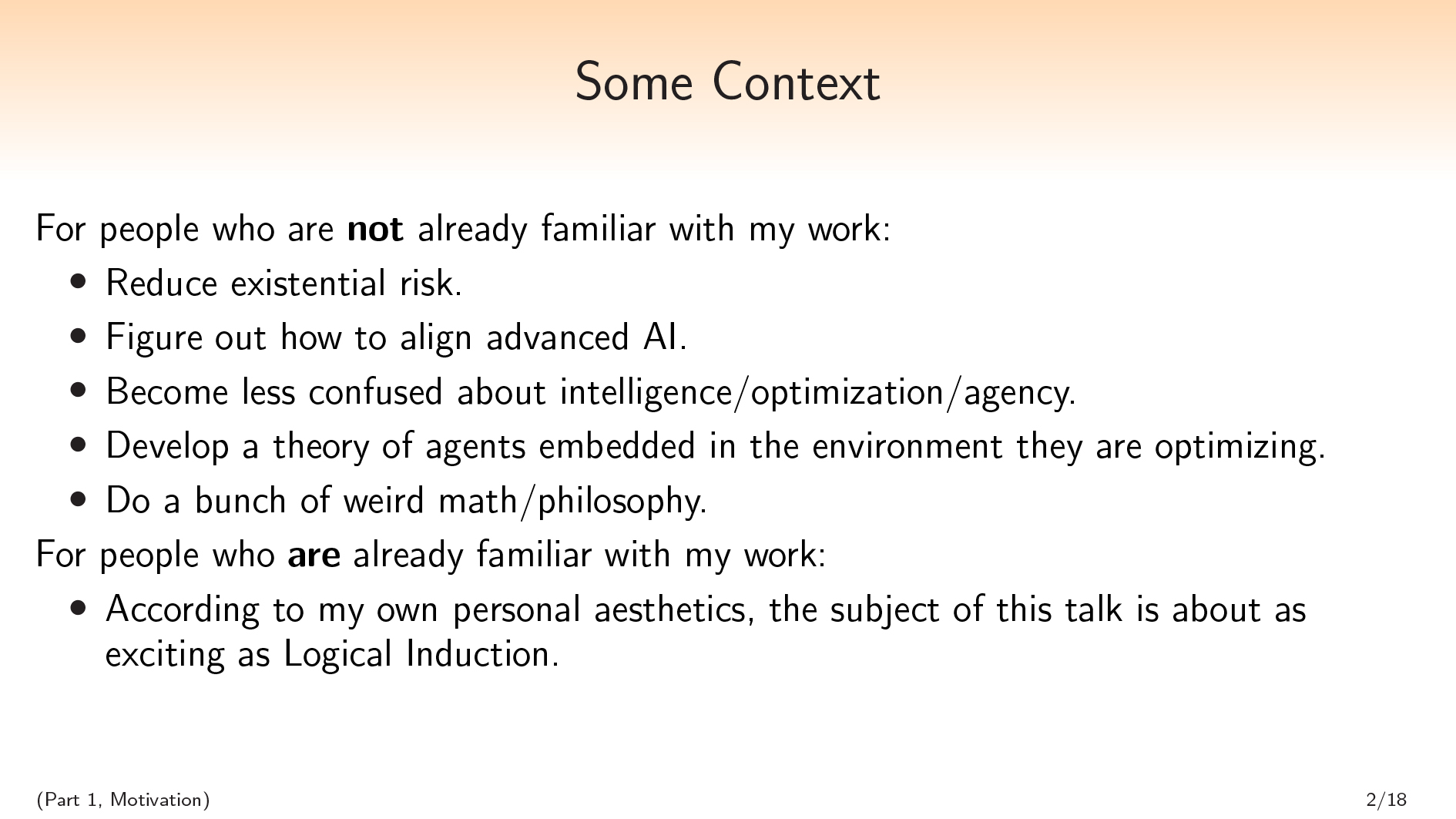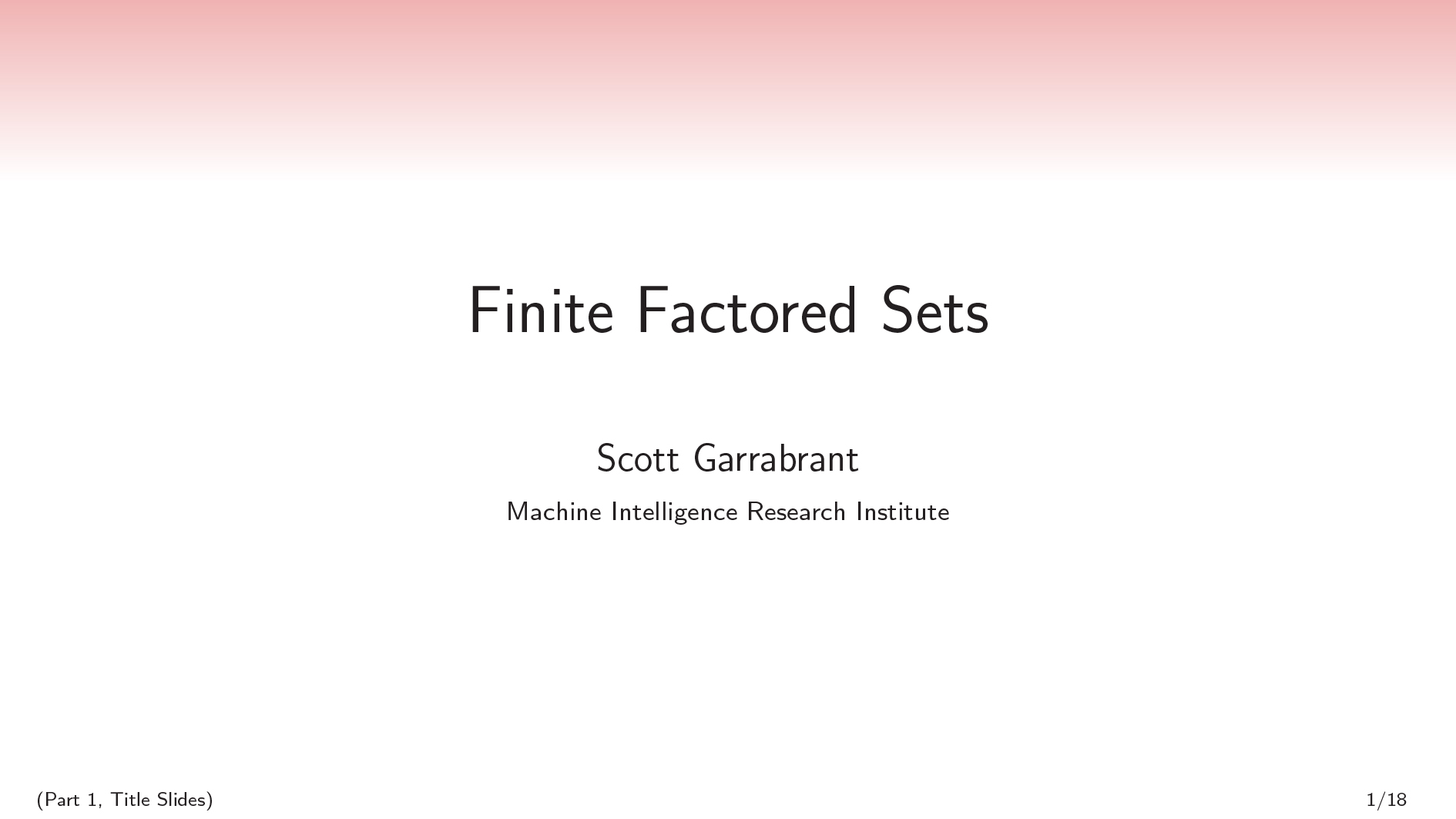Note: This is a preamble to Finite Factored Sets, a sequence I’ll be posting over the next few weeks. This Sunday at noon Pacific time, I’ll be giving a Zoom talk (link) introducing Finite Factored Sets, a framework which I find roughly as technically interesting as logical induction.
(Update May 25: A video and blog post introducing Finite Factored Sets is now available here.)
For the last few years, a large part of my research motivation has been directed at trying to save the concept of time—save it, for example, from all the weird causal loops created by decision theory problems. This post will hopefully explain why I care so much about time, and what I think needs to be fixed.
Why Time?
My best attempt at a short description of time is that time is causality. For example, in a Pearlian Bayes net, you draw edges from earlier nodes to later nodes. To the extent that we want to think about causality, then, we will need to understand time.
Importantly, time is the substrate in which learning and commitments take place. When agents learn, they learn over time. The passage of time is like a ritual in which opportunities are destroyed and knowledge is created. And I think that many models of learning are subtly confused, because they are based on confused notions of time.
Time is also crucial for thinking about agency. My best short-phrase definition of agency is that agency is time travel. An agent is a mechanism through which the future is able to affect the past. An agent models the future consequences of its actions, and chooses actions on the basis of those consequences. In that sense, the consequence causes the action, in spite of the fact that the action comes earlier in the standard physical sense.
Problem: Time is Loopy
The main thing going wrong with time is that it is “loopy.”
The primary confusing thing about Newcomb’s problem is that we want to think of our decision as coming “before” the filling of the boxes, in spite of the fact that it physically comes after. This is hinting that maybe we want to understand some other “logical” time in addition to the time of physics.
However, when we attempt to do this, we run into two problems: Firstly, we don’t understand where this logical time might come from, or how to learn it, and secondly, we run into some apparent temporal loops.
I am going to set aside the first problem and focus on the second.
The easiest way to see why we run into temporal loops is to notice that it seems like physical time is at least a little bit entangled with logical time.
Imagine the point of view of someone running a physics simulation of Newcomb’s problem, and tracking all of the details of all of the atoms. From that point of view, it seems like there is a useful sense in which the filling of the boxes comes before an agent’s decision to one-box or two-box. At the same time, however, those atoms compose an agent that shouldn’t make decisions as though it were helpless to change anything.
Maybe the solution here is to think of there being many different types of “before” and “after,” “cause” and “effect,” etc. For example, we could say that X is before Y from an agent-first perspective, but Y is before X from a physics-first perspective.
I think this is right, and we want to think of there as being many different systems of time (hopefully predictably interconnected). But I don’t think this resolves the whole problem.
Consider a pair of FairBot agents that successfully execute a Löbian handshake to cooperate in an open-source prisoner’s dilemma. I want to say that each agent’s cooperation causes the other agent’s cooperation in some sense. I could say that relative to each agent the causal/temporal ordering goes a different way, but I think the loop is an important part of the structure in this case. (I also am not even sure which direction of time I would want to associate with which agent.)
We also are tempted to put loops in our time/causality for other reasons. For example, when modeling a feedback loop in a system that persists over time, we might draw structures that look a lot like a Bayes net, but are not acyclic (e.g., a POMDP). We could think of this as a projection of another system that has an extra dimension of time, but it is a useful projection nonetheless.
Solution: Abstraction
My main hope for recovering a coherent notion of time and unraveling these temporal loops is via abstraction.
In the example where the agent chooses actions based on their consequences, I think that there is an abstract model of the consequences that comes causally before the choice of action, which comes before the actual physical consequences.
In Newcomb’s problem, I want to say that there is an abstract model of the action that comes causally before the filling of the boxes.
In the open source prisoners’ dilemma, I want to say that there is an abstract proof of cooperation that comes causally before the actual program traces of the agents.
All of this is pointing in the same direction: We need to have coarse abstract versions of structures come at a different time than more refined versions of the same structure. Maybe when we correctly allow for different levels of description having different links in the causal chain, we can unravel all of the time loops.
But How?
Unfortunately, our best understanding of time is Pearlian causality, and Pearlian causality does not do great with abstraction.
Pearl has Bayes nets with a bunch of variables, but when some of those variables are coarse abstract versions of other variables, then we have to allow for determinism, since some of our variables will be deterministic functions of each other; and the best parts of Pearl do not do well with determinism.
But the problem runs deeper than that. If we draw an arrow in the direction of the deterministic function, we will be drawing an arrow of time from the more refined version of the structure to the coarser version of that structure, which is in the opposite direction of all of our examples.
Maybe we could avoid drawing this arrow from the more refined node to the coarser node, and instead have a path from the coarser node to the refined node. But then we could just make another copy of the coarser node that is deterministically downstream of the more refined node, adding no new degrees of freedom. What is then stopping us from swapping the two copies of the coarser node?
Overall, it seems to me that Pearl is not ready for some of the nodes to be abstract versions of other nodes, which I think needs to be fixed in order to save time.
Discussion on: LessWrong
 Scott: So I want to start with some context. For people who are not already familiar with my work:
Scott: So I want to start with some context. For people who are not already familiar with my work: